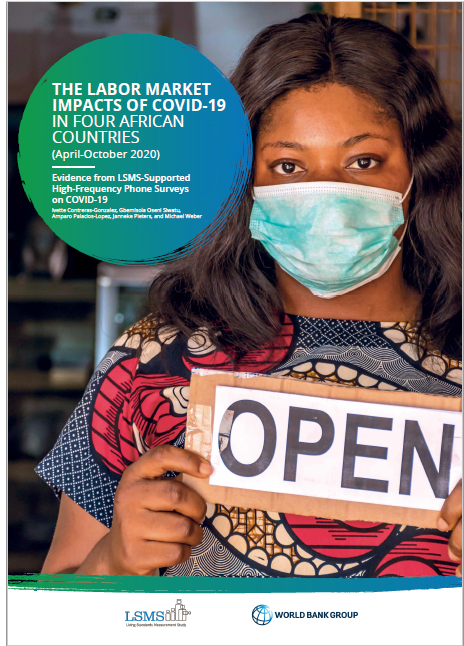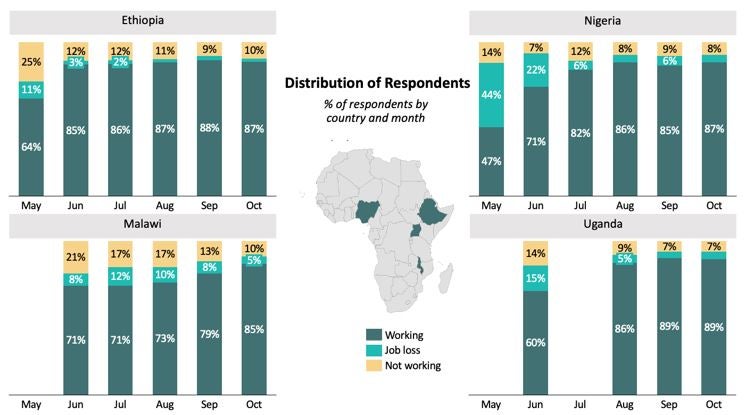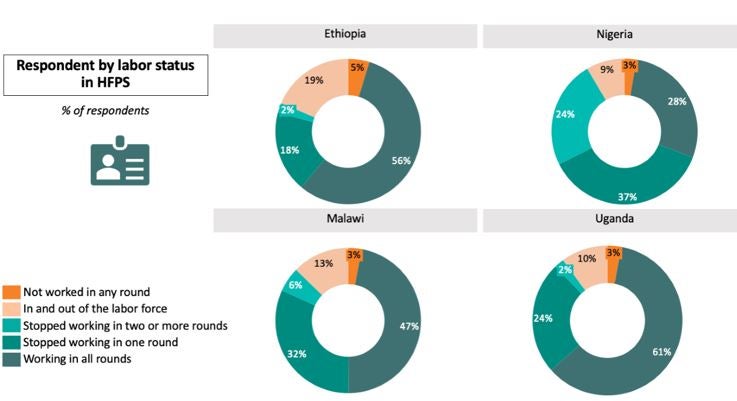 Labor markets continue to be a key transmission channel of the economic impact of COVID-19. As a result, tracking the trends in labor markets is paramount to gaining a better understanding of the economic impacts of the pandemic. Proper documentation of the disruptions as they affect the general livelihood of workers, firms, and labor incomes, can greatly inform policies intended to mitigate the negative impact of the pandemic. This blog highlights the impact of the COVID-19 pandemic on the labor market, based on surveys conducted between April and October 2020, using LSMS-Supported High‑Frequency Phone Surveys in four African countries: Ethiopia, Malawi, Nigeria, and Uganda.
Labor markets continue to be a key transmission channel of the economic impact of COVID-19. As a result, tracking the trends in labor markets is paramount to gaining a better understanding of the economic impacts of the pandemic. Proper documentation of the disruptions as they affect the general livelihood of workers, firms, and labor incomes, can greatly inform policies intended to mitigate the negative impact of the pandemic. This blog highlights the impact of the COVID-19 pandemic on the labor market, based on surveys conducted between April and October 2020, using LSMS-Supported High‑Frequency Phone Surveys in four African countries: Ethiopia, Malawi, Nigeria, and Uganda.
After the onset of the COVID-19 outbreak, a significant share of respondents in all four countries lost their jobs. By June 2020, 45% of workers in Nigeria had stopped working, compared to 17% in Uganda, 8% in Ethiopia, and 6% in Malawi. In all the countries, urban areas experienced higher job losses due to the pandemic than rural areas. Women also experienced COVID-19-related job losses at a much higher rate than men, especially in Ethiopia and Uganda. Additional information on the early impacts of the pandemic can be found here.
Following the early impacts of the pandemic, the working situation of the respondents in these countries has gradually recovered. The share of working respondents in Ethiopia increased from 64% in May to 87% in October. In Malawi, and for the same period, the same numbers were 71% and 85%, 42% and 87% in Nigeria, and 70% and 89% in Uganda.
Note: Months that are left blank are months when no data was collected. The share of respondents in the category “job loss” refers to the ones that were working in the previous round but stopped working during the round presented in the figure. In the case of the first round, the working situation is compared to mid-March 2020.
Source: Own calculations based on HFPS surveys
The duration of job losses between April and October 2020 also varied by country, reflecting some level of instability in the labor markets. In Nigeria, only 28.2% of respondents in the panel remained working during all rounds, while 36.8% had stopped working during one round, and 23.9% for two or more rounds. In Malawi, 46.9% of the respondents were working during all rounds, 31.9% had stopped working during one round, and only 5.5% had stopped working for two or more rounds. In Ethiopia, 54.6% of the respondents were working during all rounds, 18.0% had stopped working during one round, and 18.6% were in and out of the labor force. In Uganda, 60.5% of respondents were working during all the rounds and only 2.1% had stopped working for two or more rounds.
Note: The category “Not worked in any round” includes respondents that did not work in any round either if they search for a job or not. The category “In and out of the labor force” requires at least one round working.
Source: Own calculations based on HFPS surveys
Even though, the share of respondents with a job returned to pre-pandemic levels in all countries, the recovery has been uneven. The data from Nigeria and Malawi show that when considering the rounds in which all household members were interviewed, the labor market recovery from the shock of the pandemic does not appear to be even across the board.
The data on working-age adults captured in Nigeria and Malawi reveals gender inequalities. In Nigeria, 77.6% of the male respondents were working in September 2020, compared to 82.3% at the last face-to-face survey conducted in 2018. This shows a reduction of 4.7% in working males, which could be attributed to the pandemic. This number is slightly higher for women, at 6.3%.
In Malawi, female respondents are a long way from returning to pre-pandemic levels of work. As of October 2020, male respondents were 4.4 percentage points less likely to work (66.5% -70.9%), which is similar to the gap for males in Nigeria. However, 64.8% of female respondents were working in 2019, but this fell to 55.6% in October 2020, resulting in a gap of 9.2 percentage points.
As the pandemic continues to persist, policies should be targeted to the groups that have been hit the hardest. The urban sector and women of working age have seen a much slower recovery when compared to their rural and male counterparts. Moreover, in addition to the COVID-19 impact through job loss, there are other considerable factors that may affect households’ income, such as reduced business activity or a decrease in working hours.
Resources:
- Read the full cross-country brief
- Find out more about the LSMS-supported COVID-19 high-frequency phone surveys








Join the Conversation